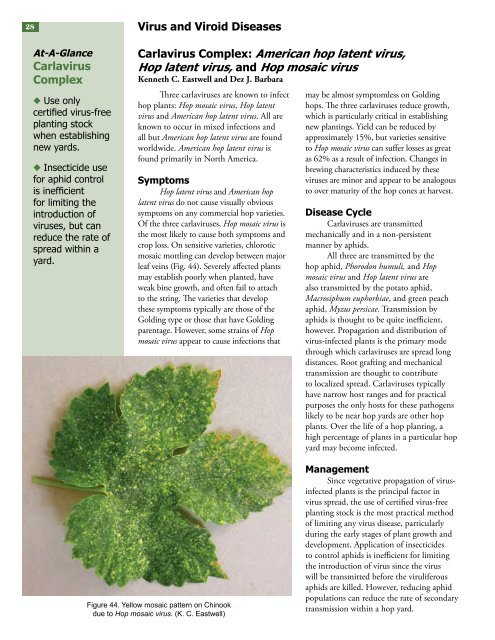Field Guide for Integrated Pest Management in Hops
Field Guide for Integrated Pest Management in Hops
Field Guide for Integrated Pest Management in Hops
Create successful ePaper yourself
Turn your PDF publications into a flip-book with our unique Google optimized e-Paper software.
28At-A-GlanceCarlavirusComplex◆◆Use onlycertified virus-freeplant<strong>in</strong>g stockwhen establish<strong>in</strong>gnew yards.◆◆Insecticide use<strong>for</strong> aphid controlis <strong>in</strong>efficient<strong>for</strong> limit<strong>in</strong>g the<strong>in</strong>troduction ofviruses, but canreduce the rate ofspread with<strong>in</strong> ayard.Virus and Viroid DiseasesCarlavirus Complex: American hop latent virus,Hop latent virus, and Hop mosaic virusKenneth C. Eastwell and Dez J. BarbaraThree carlaviruses are known to <strong>in</strong>fecthop plants: Hop mosaic virus, Hop latentvirus and American hop latent virus. All areknown to occur <strong>in</strong> mixed <strong>in</strong>fections andall but American hop latent virus are foundworldwide. American hop latent virus isfound primarily <strong>in</strong> North America.SymptomsHop latent virus and American hoplatent virus do not cause visually obvioussymptoms on any commercial hop varieties.Of the three carlaviruses, Hop mosaic virus isthe most likely to cause both symptoms andcrop loss. On sensitive varieties, chloroticmosaic mottl<strong>in</strong>g can develop between majorleaf ve<strong>in</strong>s (Fig. 44). Severely affected plantsmay establish poorly when planted, haveweak b<strong>in</strong>e growth, and often fail to attachto the str<strong>in</strong>g. The varieties that developthese symptoms typically are those of theGold<strong>in</strong>g type or those that have Gold<strong>in</strong>gparentage. However, some stra<strong>in</strong>s of Hopmosaic virus appear to cause <strong>in</strong>fections thatmay be almost symptomless on Gold<strong>in</strong>ghops. The three carlaviruses reduce growth,which is particularly critical <strong>in</strong> establish<strong>in</strong>gnew plant<strong>in</strong>gs. Yield can be reduced byapproximately 15%, but varieties sensitiveto Hop mosaic virus can suffer losses as greatas 62% as a result of <strong>in</strong>fection. Changes <strong>in</strong>brew<strong>in</strong>g characteristics <strong>in</strong>duced by theseviruses are m<strong>in</strong>or and appear to be analogousto over maturity of the hop cones at harvest.Disease CycleCarlaviruses are transmittedmechanically and <strong>in</strong> a non-persistentmanner by aphids.All three are transmitted by thehop aphid, Phorodon humuli, and Hopmosaic virus and Hop latent virus arealso transmitted by the potato aphid,Macrosiphum euphorbiae, and green peachaphid, Myzus persicae. Transmission byaphids is thought to be quite <strong>in</strong>efficient,however. Propagation and distribution ofvirus-<strong>in</strong>fected plants is the primary modethrough which carlaviruses are spread longdistances. Root graft<strong>in</strong>g and mechanicaltransmission are thought to contributeto localized spread. Carlaviruses typicallyhave narrow host ranges and <strong>for</strong> practicalpurposes the only hosts <strong>for</strong> these pathogenslikely to be near hop yards are other hopplants. Over the life of a hop plant<strong>in</strong>g, ahigh percentage of plants <strong>in</strong> a particular hopyard may become <strong>in</strong>fected.Figure 44. Yellow mosaic pattern on Ch<strong>in</strong>ookdue to Hop mosaic virus. (K. C. Eastwell)<strong>Management</strong>S<strong>in</strong>ce vegetative propagation of virus<strong>in</strong>fectedplants is the pr<strong>in</strong>cipal factor <strong>in</strong>virus spread, the use of certified virus-freeplant<strong>in</strong>g stock is the most practical methodof limit<strong>in</strong>g any virus disease, particularlydur<strong>in</strong>g the early stages of plant growth anddevelopment. Application of <strong>in</strong>secticidesto control aphids is <strong>in</strong>efficient <strong>for</strong> limit<strong>in</strong>gthe <strong>in</strong>troduction of virus s<strong>in</strong>ce the viruswill be transmitted be<strong>for</strong>e the viruliferousaphids are killed. However, reduc<strong>in</strong>g aphidpopulations can reduce the rate of secondarytransmission with<strong>in</strong> a hop yard.








